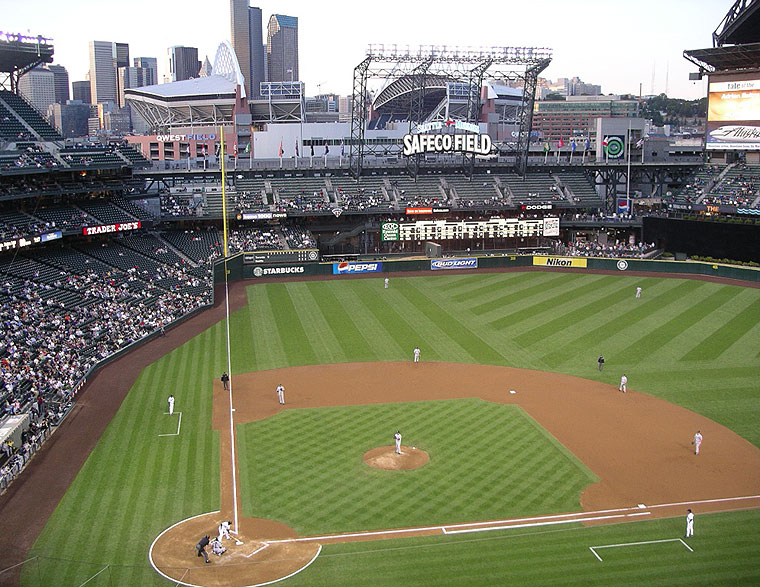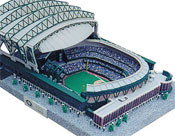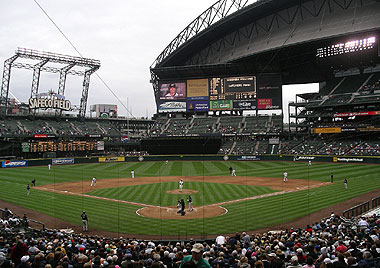
|
Safeco Field encompasses all the best qualities of the modern ballpark: choice downtown location, plenty of local flavor, and innovation that benefits fans.
Seattle’s ballpark is as distinct as any you will find in the Major Leagues, and it all has to do with the first thing you notice about it: the one-of-a-kind retractable roof. The Mariners are one of five teams to play in a ballpark with a retractable roof, but Seattle’s roof is so unique – engineers from around the world come to take notes – that Safeco Field is easily the best of the bunch. While watching a game indoors at Toronto, Arizona, Houston or Milwaukee (the four other “convertible” ballparks) feels like being inside baseball’s most dreaded type of venue - a Dome – that’s not the case in Seattle, thanks to an innovative roof design (and a lot of dollars). What makes Safeco’s roof so special is that it covers, but does not enclose, the ballpark. This means that whether the roof is open or closed, the ballpark maintains an open-air atmosphere. And baseball is always best watched in that type of environment. What makes the seemingly implausible possible is the clever design of the retractable roof, which consists of three panels that glide along “train tracks” that extend the length of the ballpark’s exterior on two sides. The roof can open or close in 14-18 minutes by gliding upon the tracks courtesy of 128 steel wheels that are powered by 96 ten horsepower electric motors. When the roof is retracted it’s actually housed separate from the ballpark, forming what can best be described as an open-air shed that protects the railroad tracks that bypass Safeco in right field. Approaching the ballpark by foot it’s a strange sight to behold, but you pretty much forget the roof is hovering there while watching the game. The Mariners needed a roof for their ballpark due to Seattle’s notorious rain, and the only time the team shuts Safeco’s roof is when it’s raining or the temperature drops below 40 degrees. But since the roof functions like an umbrella, many fans are still exposed to cool weather when the roof is “shut.” Although thick glass plates in the upper deck help insulate fans in the main grandstand, those sitting in the outfield bleachers have no such protection. Even when the roof is closed, the left field bleachers have cover above but nothing behind them, meaning cold air and wind have free reign. Those sitting in the center field bleachers have a little more protection, as the main ballpark scoreboard runs the length of the section and acts as a buffer against the elements. Since pockets of exposed areas exist throughout the outfield even when the roof is closed, fans wanting to stay warm should stay away from the bleachers and seats in the main grandstand closest to the outfield.
Located on the southern edge of downtown Seattle (SoDo), Safeco Field takes advantage of its location by offering fans sweeping views of the city skyline plus an up-close view of the ballpark’s next door neighbor, Qwest Field. Home of the NFL’s Seahawks, Qwest Field occupies the space formerly taken up by the Kingdome, where the Mariners played their first 22½ seasons. Although not visible from Safeco’s seats, the ballpark is built on the edge of the Puget Sound. The water is easily visible from the third base grandstand concourse, the same place where fans can also spot a glimpse of the world famous Space Needle, located 2½ miles away in Seattle’s City Center, the regional name given to a city’s downtown. The seating section inside the ballpark where fans can see the Puget Sound and Space Needle is the Lookout Landing, located at the end of the left field grandstand in the upper deck. As its name suggests, fans have a 360-degree view of inside and outside the ballpark from the Landing. One of the benefits of Safeco Field’s location – in an industrial area on the edge of downtown - is there are plenty of options available for parking, although rates at the same lots vary from day-to-day depending on whether the game is on a weekday or weekend and played at day or night. Befitting the often overcast Seattle skies, the roof and its enormous support structure are painted in a drab hue of gray that serve as the main impression of Safeco Field’s exterior. But the ballpark does have a picturesque brick rotunda located behind home plate that serves as the official entrance. The third base façade, home to the Mariners official team store, is also built with brick.
Inside the ballpark, the Mariners offer all the modern-day comforts fans expect. The Hit It Here Café in right field, complete with three levels of tiered outdoor seating, is the ballpark’s official restaurant. Numerous concessionaires with local connections are available throughout Safeco, including stands offering garlic fries, seafood and the very tasty Kidd Valley milkshakes. Safeco Field does an amazing job at bringing fans close to the action thanks to the Bullpen Market concourse in left field, which offers many places to stand and enjoy the game. Among the many great options for unique vantage points, the patio in center field is the best. Located next to the Mariners bullpen and just slightly above field level, the Bullpen Market patio is a great place to hang out, have a drink and watch the game. The only thing between you and the playing field is the outfield fence. Underneath the hand-operated scoreboard adjacent to the left field foul pole is a small bar that literally lets you peer over the left fielder’s shoulder through slits just above the fence. Bullpens for both teams are as accessible as any in the Major Leagues. Only a chain-link fence separates fans from pitchers warming up. Want to know what it’s like to sit in the bullpen or how it feels to face a big league fastball? Just stand behind the fence and find out! To the Mariners credit, they’ve made Safeco Field comfortable for fans in all sections. Even the bleachers, long the bastion of cheap yet uncomfortable seating, are padded. Every seat, bleachers included, is painted green, meaning there’s no color-coding of the seating areas depending on price. Unimportant as it might seem, a uniform seat color gives the ballpark a harmonious look (take note Dodger Stadium). In right field the team proudly displays three A.L. West Champions banners, including the 2001 banner of the team that won a Major League-record 116 games. The out-of-town scoreboard is above the bullpen in left-center field. Absent from Safeco Field are any retired numbers – the Mariners are one of four teams not to retire any yet. When they do, it will most likely be the # 11 belonging to Edgar Martinez, who played 18 seasons for the Mariners. Martinez remains so revered in Seattle that a street running parallel to the ballpark, S. Atlantic Street, was renamed Edgar Martinez Drive in October 2004. Although the retractable roof solved the problem of rain, the setting sun in Seattle caused numerous problems when its rays reflected off the batter’s back drop, making it difficult for hitters to pick up pitches in the late afternoon and early evening. The Mariners fixed that problem by putting up a series of sun screens in the upper deck behind home plate, but Safeco still has the worst sun field in baseball. Regardless of the problem with the sun, Safeco Field is a fan’s delight and the ballpark has become as much a part of the fabric of Seattle as another local architectural icon, the Space Needle. Both are gems of the Pacific Northwest and synonymous with excellence for their unique design and ability to attract lots of people. The Mariners’ move to Safeco Field has been a boom for team attendance. Poor play by a hapless franchise (no winnings seasons until 1991) lead to years of fan apathy in Seattle and the Mariners drew below the league average in attendance from their inception in 1977 until 1996. Since Safeco opened in mid-summer 1999, the Mariners have drawn over 3 million fans four times. By contrast, the team drew more than 2 million fans just five times in over two decades at the Kingdome. A large contingent of the Mariners fan base is Japanese, thanks to Ichiro Suzuki and fellow Japanese stars Kazuhiro Sasaki and Kenji Johjima. The team is also owned by a Japanese businessman, Hiroshi Yamauchi, and the Mariners even serve sushi at Safeco. A hit with fans of all nationalities, Safeco Field is one of the gems in Major League Baseball and, unique for its openness, the best in the class of retractable roofed ballparks.

Safeco Field Footnotes - Facts & Figures
| ||||||||||||||||||||||||||||||||||||||||



 Unique in function and appearance, the one-of-a-kind roof design is Safeco Field’s signature feature, but the ballpark doesn’t rely on engineering marvels to make it one of the best in baseball.
Unique in function and appearance, the one-of-a-kind roof design is Safeco Field’s signature feature, but the ballpark doesn’t rely on engineering marvels to make it one of the best in baseball.
 Safeco Field has garnered more notoriety for noise outside the ballpark than inside it, thanks to the train tracks that run behind right field. According to Burlington Northern, about five trains pass by Safeco Field during each game, and the trains normally blow two long whistles, followed by a short blast and another long one as they go through the intersection just outside right-center field.
Safeco Field has garnered more notoriety for noise outside the ballpark than inside it, thanks to the train tracks that run behind right field. According to Burlington Northern, about five trains pass by Safeco Field during each game, and the trains normally blow two long whistles, followed by a short blast and another long one as they go through the intersection just outside right-center field.

